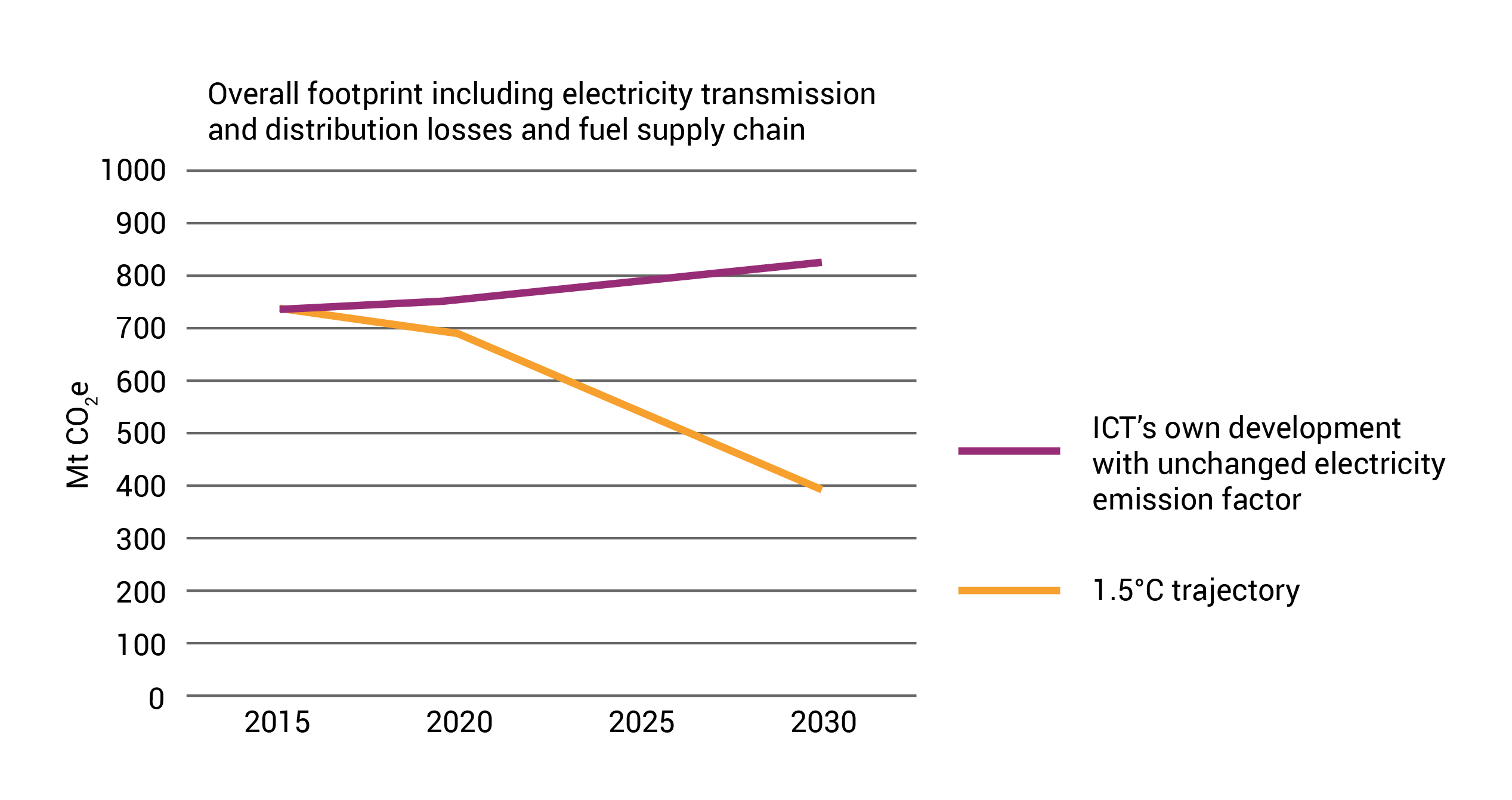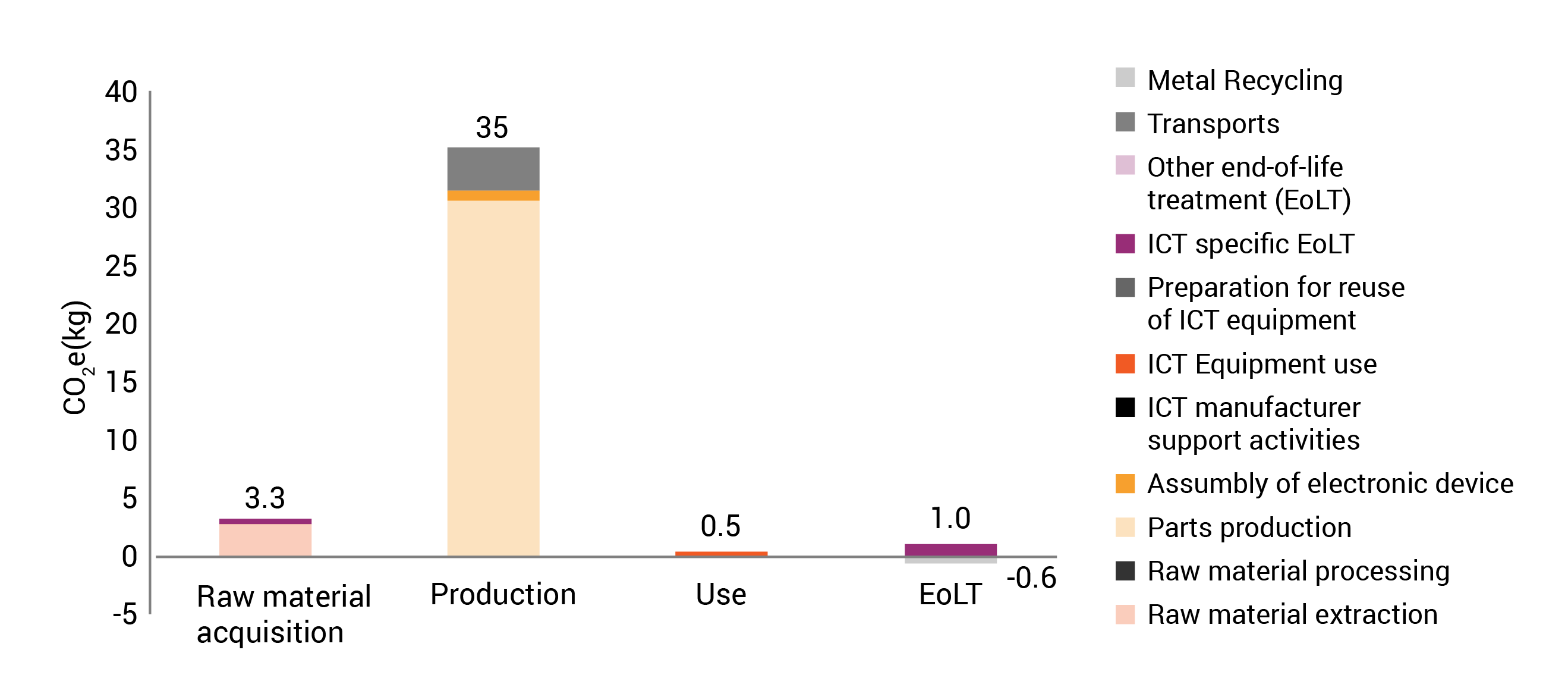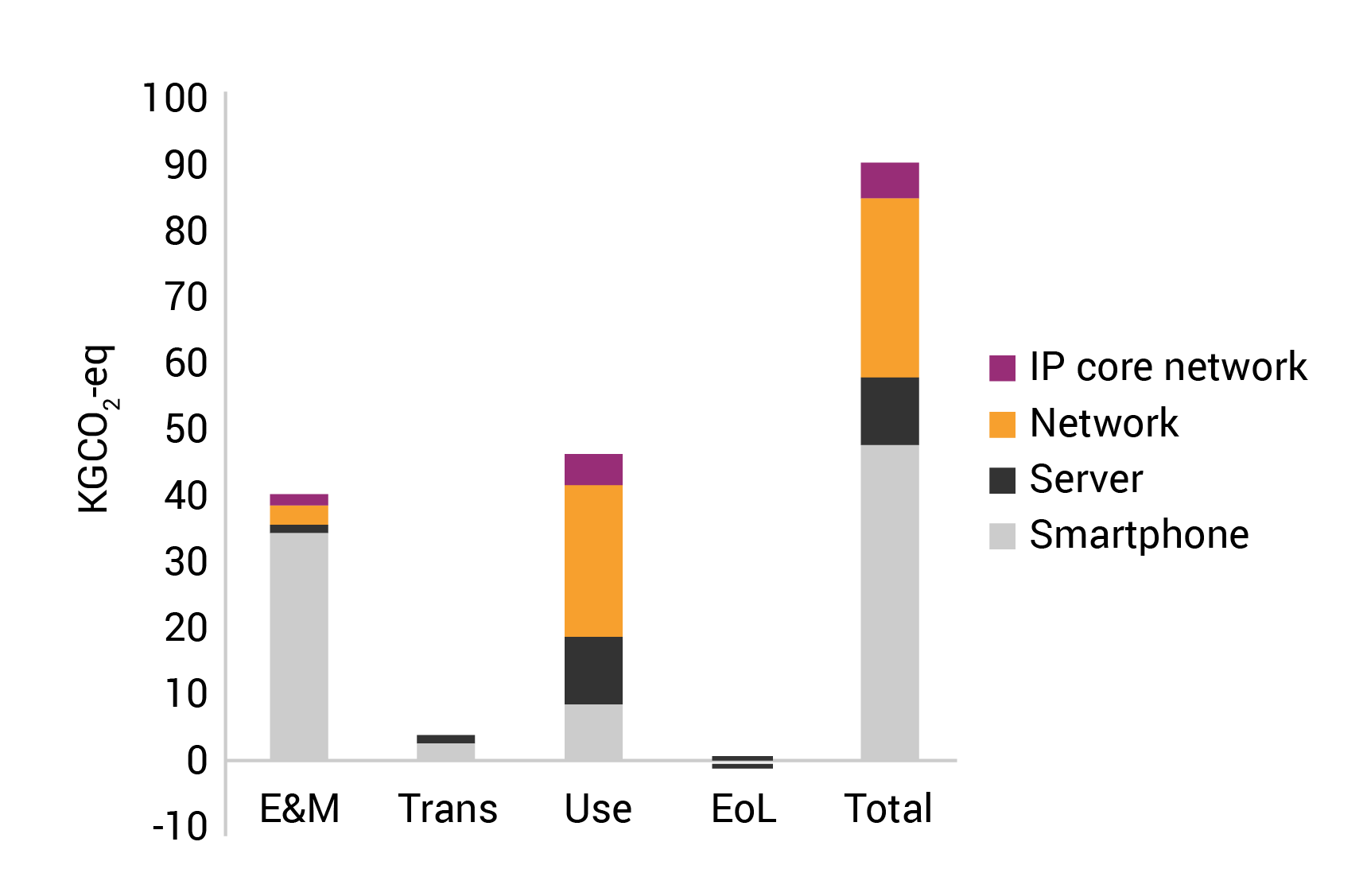Module 1: The environmental impact of a digital device
In 10 years’ time, digital devices will account for nearly a quarter of global emissions, with the main contributors being mining raw materials to make the devices, transport and production.
Our devices consume natural resources
These days, some form of electrical or electronic device can be found in almost any household or business. From products such as cheap electronic toys or digital watches, to basic kitchen appliances, radios and TVs, to mobile phones, laptops or tablet computers. Many of these devices are connected to the internet and therefore interact and are interdependent with other devices.
The problem is that as more people get online, more people also have more devices per person. And this has a downstream impact: more mobiles, laptops and desktops mean more cloud providers, more servers, more broadband cables and mobile networks.
Over six billion new information and communications technology (ICT) goods are sold annually worldwide. There are forecasts of 1.5 billion smartphones being sold in 2021,[1] alongside 126 million desktop computers, 659 million laptops, and 513 million Wi-Fi routers. These numbers are expected to grow exponentially over the next five to 10 years with new “smart” technologies.[2]
This has made e-waste the largest waste stream in many countries, with most of it discarded in the general waste stream, leading to a loss of secondary resources valued at USD 57 billion in 2019[3] (more than the gross domestic product of many countries). At the same time, e-waste is often shipped illegally to developing countries.[4]
Figure 1: Metric tons of carbon dioxide equivalent (Mt CO2e) footprint of the ICT industry by 2030: the challenge of combining growth with a radical reduction to half. Source: ITU-T L.1470
The contribution of this exponential connectivity to electricity use is also a major problem: it is anticipated that by 2030, ICTs could use as much as 51% of global electricity, and contribute up to 23% of the globally released greenhouse gas (GHG) emissions.[5]
While renewable energy can help reduce GHG emissions,[6] the production of digital devices remains the key contributor to global warming. This includes upstream activities such as mining for raw materials, transport and manufacturing, which account for most of the negative impact on emissions.[7]
Assessing the environmental impact of a device
A need for dataThe impact assessment of materials, energy and related processes along the life cycle of devices improves if there is data that allows us to understand the social, environmental and economic impacts of digital devices. Often good data on e-waste does not exist, while collecting primary data from component manufacturers is time consuming and difficult (e.g. confidentiality problems occur).[8] |
There are methods for assessing the environmental impacts associated with all stages of the life cycle of a digital device. A life-cycle assessment (LCA) study involves a thorough inventory of the energy, materials and emissions that are required and consumed in the manufacture or across the expected life span of a device, and is what we call a “cradle-to-grave” evaluation of all stages of the life of a digital product.[9]
It has been shown for smartphones that device production has about a 75 times higher environmental impact than a two-year-use life span,[10] as Figure 2 shows. But we also have to include the internet[11] – mobile access network, internet, server – as shown in Figure 3. Despite the variability of networks and servers in different contexts, after the impact of the production of the smartphone, data transfer has a major impact (locality, or having servers nearby, matters), followed by cloud data processing.
The environmental impact from manufacturing a device is very high compared to its use and final recycling. This tells us that using a device as long as possible is a better environmental choice than manufacturing more devices, especially those that will be discarded or replaced soon after use.
Figure 2: The global warming potential for a mobile phone with two-year use life cycle. Source: A. Andrae, Life-Cycle Assessment of Consumer Electronics
Figure 3: GHG emissions across the life cycle of a smartphone (white) including contribution from a rack server (black), network (dots) and IP core network (diagonal). Source: Suckling 2015.
What does reusing a device mean?
The reuse of electronic devices such as desktops, laptops or mobile phones refers to extending the useful life of already manufactured devices after they have been discarded. Larger-scale reuse operations usually involve a company or organisation set up to do this work. These devices are usually collected by a second-hand agent or sent to a remanufacturer for processing, and are sold, rented or redistributed to another user.
In a computing device we can distinguish between the long-lasting parts, what can deteriorate (degrade or wear down, like batteries), what should be replaced (like a hard drive after a certain number of hours), and what is extensible (such as RAM or peripherals). The reuse process ends when, after a few years, the device or a component becomes unusable, even considering improvements from replacing components. It is at this point that a device should end up in recycling, a process that results in extracting useful raw materials from the recycled device.[12]
There are numerous reuse initiatives across the world, some involving digital devices, and some other products. This is all part of a growing culture of reuse. For example, Repair Café is a non-profit organisation that began as an idea in 2007 to build skills to repair digital devices. There are now 2,000 Repair Cafés in more than 24 countries. In 2017, over 300,000 digital devices were repaired.[13] Repair Café recognises that in many countries we throw away items with almost nothing wrong with them because we do not have the skills to repair them. Repair Cafés aim to involve people with repair skills to share their knowledge, enabling digital devices to have longer lives instead of being thrown away.
Responding quicker to a crisis by reusing old computersDuring the peak of the COVID-19 pandemic there was a sudden demand for computers in Europe, especially for home schooling. The usual “let’s buy them” way didn’t work: the global supply chain could not manufacture and deliver so many new computers. At the same time, many discarded but usable devices were piling up, waiting to be refurbished and reused. By using these, reuse activists could respond to the new need and prepare and distribute computers in a matter of days, while new computers took about a year to arrive, too late for the confinement period.[14] |
Club de Reparadores: Promoting a culture of repair
By Florencia Roveri, Nodo TAU
Club de Reparadores (Repairers Club) is an initiative launched in Argentina in November 2015 by the organisation Artículo 41,[15] with the intention of raising awareness of repair as a sustainable practice of responsible consumption. It was inspired by movements developed in other countries.
Club de Reparadores aims to promote the repair of objects (home appliances, toys, books, furniture, bikes, radios, TV sets, phones and computers, among others) to extend their useful life. It contributes to advocating a culture of repair, developing and sharing skills in repairing, and emphasising care and closeness as social values.
It has organised itinerant repair events called “clubs” in different neighbourhoods in Buenos Aires, as well as other cities such as Córdoba, Bariloche and Rosario, and supports the organisation of the events by mapping and collecting information of local repairers and other actors of the local economy. These are published on the online platform https://reparar.org.
The project is creative in messaging, which is shared widely. The events involve people of different ages – although mainly young people who work with electronics and information and communications technology (ICT) devices – and men and women in equal number.
So far, Club de Reparadores has held 64 events. These have received 2,976 products in need of repair, and involved 335 voluntary repairers and 3,471 assistants. A total of 1,934 products have been repaired in the process.
The project has had an impact in three ways: environmental, because extending the useful life of things reduces the production of new products, which in turn reduces the generation of waste and carbon emissions; economic, because the project promotes the work of the neighbourhood repairers who become key pieces in a circular economy model; and cultural, in that it challenges the consumer culture of disposable goods and programmed obsolescence, and values the traditional knowledge of repair, reinforcing collaboration and building social resilience. |
Appendix 1: Metrics for materials, devices, energy
The environmental impact of a device can be grouped under the categories of “materials”, “devices” and “energy”.
|
Aspect |
Description |
Related metric |
Units measured |
Sources |
|
Materials |
Raw materials painfully extracted[16] from nature and the impacts on local ecosystems; secondary materials extracted from recycling; and mixed materials or e-waste dumped as polluting waste and fumes. |
Abiotic resource depletion potential (ADP): Abiotic refers to natural resources (including energy resources) such as iron ore or crude oil which are regarded as non-living. It relates to the decrease of availability of the total reserve of potential resources. |
Antimony equivalent (Sb-e) units |
|
|
Devices |
Design, manufacturing, procurement, deployment, reuse of devices and parts, recycling. |
Global warming potential at 100 years (GWP, GWP100): Ratio of the warming of the atmosphere caused by one greenhouse gas to that caused by a similar mass of carbon dioxide, calculated over a specific time frame of 100 years. |
Carbon dioxide equivalent (CO2e) units |
|
|
Energy |
Generation, consumption, |
Cumulative energy demand (CED): The energy consumption from renewable and non-renewable resources. |
Joule |
References
[1] Statista. (2021). Number of smartphones sold to end users worldwide from 2007 to 2021 (in million units). https://www.statista.com/statistics/263437/global-smartphone-sales-to-end-users-since-2007
[3] Forti, V., Baldé, C. P., Kuehr, R., & Bel, G. (2020). The Global E-waste Monitor 2020: Quantities, flows and the circular economy potential. United Nations University (UNU)/United Nations Institute for Training and Research (UNITAR) – co-hosted SCYCLE Programme, International Telecommunication Union (ITU) & International Solid Waste Association (ISWA). http://ewastemonitor.info/wp-content/uploads/2020/07/GEM_2020_def_july1_low.pdf
[4] Department of Economic and Social Affairs of the United Nations Secretariat. (2010). Trends in Sustainable Development: Chemicals, mining, transport and waste management. https://sdgs.un.org/publications/trends-sustainable-development-chemicals-mining-transport-waste-management-2010-2011
[5] Andrae, A., & Edler, T. (2015). On Global Electricity Usage of Communication Technology: Trends to 2030. Challenges, 6(1), 117-157. https://doi.org/10.3390/challe6010117
[6] Amponsah, N. Y., Troldborg, M., Kington, B., Aalders, I., & Hough, R. L. (2014). Greenhouse gas emissions from renewable energy sources: A review of lifecycle considerations. Renewable and Sustainable Energy Reviews, 39, 461-475. https://doi.org/10.1016/j.rser.2014.07.087
[7] Andrae, A. S. G. (2016). Life-Cycle Assessment of Consumer Electronics: A review of methodological approaches. IEEE Consumer Electronics Magazine, 5(1), 51-60. https://ieeexplore.ieee.org/document/7353286
[8] Proske, M., et al. (2020). Life cycle assessment of the Fairphone 3. Fraunhofer IZM. https://www.fairphone.com/wp-content/uploads/2020/07/Fairphone_3_LCA.pdf
[9] Weetman, C. (2017). A Circular Economy Handbook for Business and Supply Chains. Kogan Page. https://global-recycling.info/archives/1585
[10] Andrae, A. (2016). Op. cit. Life-Cycle Assessment of Consumer Electronics: A review of methodological approaches. In IEEE Consumer Electronics Magazine 5.1, pp. 51–60. https://ieeexplore.ieee.org/document/7353286
[11] Suckling, J., & Lee, J. (2015). Redefining scope: The true environmental impact of smartphones? International Journal of Life Cycle Assessment, 20, 1181-1196. https://doi.org/10.1007/s11367-015-0909-4
[12] Franquesa, D., & Navarro, L. (2018). Devices as a Commons: Limits to premature recycling. In Proceedings of the Second Workshop on Computing within Limits (LIMITS ’18). ACM. https://computingwithinlimits.org/2018/papers/limits18-franquesa.pdf
[13] Repair Café. (2018, 20 June). Repair Cafés save 300.000 products. https://www.repaircafe.org/en/repair-cafes-save-300-000-products
[14] Proctor, N. (2020, 2 September). The Right to Repair could help address a critical shortage in school computers. U.S. PIRG. https://uspirg.org/blogs/blog/usp/right-repair-could-help-address-critical-shortage-school-computers
[15] The name of the organisation (Article 41) is a reference to the article of the Argentine national constitution that promotes protection of the environment as a right and as a duty.
[16] “Ecological amputation” as the physical removal of ecosystems in open-pit mega-mining. See Gudynas, E. (2018). Extractivisms: Tendencies and consequences. In R. Munck & R. Delgado Wise (Eds.), Reframing Latin American Development. Routledge. http://gudynas.com/wp-content/uploads/GudynasExtractivismsTendenciesConsquences18.pdf
[17] ITU-T. (2016). L.Sup32: Supplement for eco-specifications and rating criteria for mobile phones eco-rating programmes. https://www.itu.int/rec/T-REC-L.Sup32-201610-I
[18] van Oers, L., de Koning, A., Guinée, J. B., & Huppes, G. (2002). Abiotic resource depletion in LCA: Improving characterisation factors for abiotic resource depletion as recommended in the new Dutch LCA handbook. Road and Hydraulic Engineering Institute. http://www.leidenuniv.nl/cml/ssp/projects/lca2/report_abiotic_depletion_web.pdf
[19] https://en.wikipedia.org/wiki/Global_warming_potential
[20] ITU-T. (2014). L.1410: Methodology for environmental life cycle assessments of information and communication technology goods, networks and services. https://www.itu.int/rec/T-REC-L.1410
[21] Ibid.




No Comments